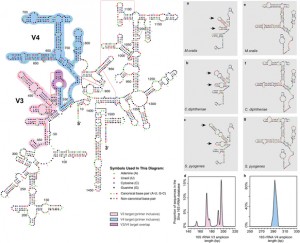A terrifying, yet not surprising article was published today in The Lancet Infectious Diseases about mcr-1. For those who aren’t familiar with it, mcr-1 is a gene associated with antibiotic resistance to colistin, a type of polymyxin antibiotic used to treat infections that are already resistant to several other types of antibiotics. News sources have …
Here are some new papers of interest. Separate treatment of hospital and urban wastewaters: A real scale comparison of effluents and their effect on microbial communities – Teofana Chonova, François Keck, Jérôme Labanowski, Bernard Montuelle, Frédéric Rimet, Agnès Bouchez – Science of the Total Environment (not OA) Hospital wastewaters (HWW) contain wider spectrum and higher quantity of pharmaceuticals …
I confess I have not read this yet but it seems like it may be of interest to some out there in the microbial communities community: REAGO: Reconstructing 16S rRNA genes in metagenomic data.
To date, characterization of ancient oral (dental calculus) and gut (coprolite) microbiota has been primarily accomplished through a metataxonomic approach involving targeted amplification of one or more variable regions in the 16S rRNA gene. For anyone interested in rRNA studies of microbial communities, ancient microbiomes, or analysis of samples with small amounts of DNA this …
So our first attempt at entering the world of bacterial taxonomy and the description of a new species came out today with the thrilling title of “Porphyrobacter mercurialis sp. nov., isolated from a stadium seat and emended description of the genus Porphyrobacter“. The story leading to this paper took us into a lot of new …
Here are the papers on the built environment microbiology that I found in the past weeks. For more microbiology papers, please check out my daily blog MicrobiomeDigest. Copper surfaces are associated with significantly lower concentrations of bacteria on selected surfaces within a pediatric intensive care unit – Michael G. Schmidt – American Journal of Infection …
More good news for animal lovers! A recent study on the effects of exposure to dogs and farm animals on childhood asthma was just published in JAMA Pediatrics. The article is entitled Early Exposure to Dogs and Farm Animals and the Risk of Childhood Asthma by T. Fall, C. Lundholm, A.K. Örtqvist, K. Fall, F. Fang, Ã…. Hedhammar, O. Kämpe, E. Ingelsson, C. Almqvist. Here is the …
The latest papers on microbiome of buildings and other objects used by humans. Today, we have microbiomes of water reservoirs and plumbing pipes, Brazilian money notes, an Italian cheese factory, and a brewery. For more microbiome papers from other sources (both human-associated or environmental), check out my daily blog MicrobiomeDigest.com. Impact of Water Chemistry, Pipe …
When we think of the built environment, we usually only include the indoor surfaces and air. A new study (preprint) posted last week on BioRxiv went through the roof, and looked at the microbes living on solar panels. A highly diverse, desert-like microbial biocenosis on solar panels in a Mediterranean city – Pedro Dorado-Morales, Cristina Vilanova, Juli …
We expect people next door to be good citizens and would like to meet them before moving in. When it comes to the neighbors living in our tap water, precaution is especially in order. In the “Microbial Neighbors in your Tap Water” series, our PLoS ONE paper released today introduces these invisible neighbors- the building …

